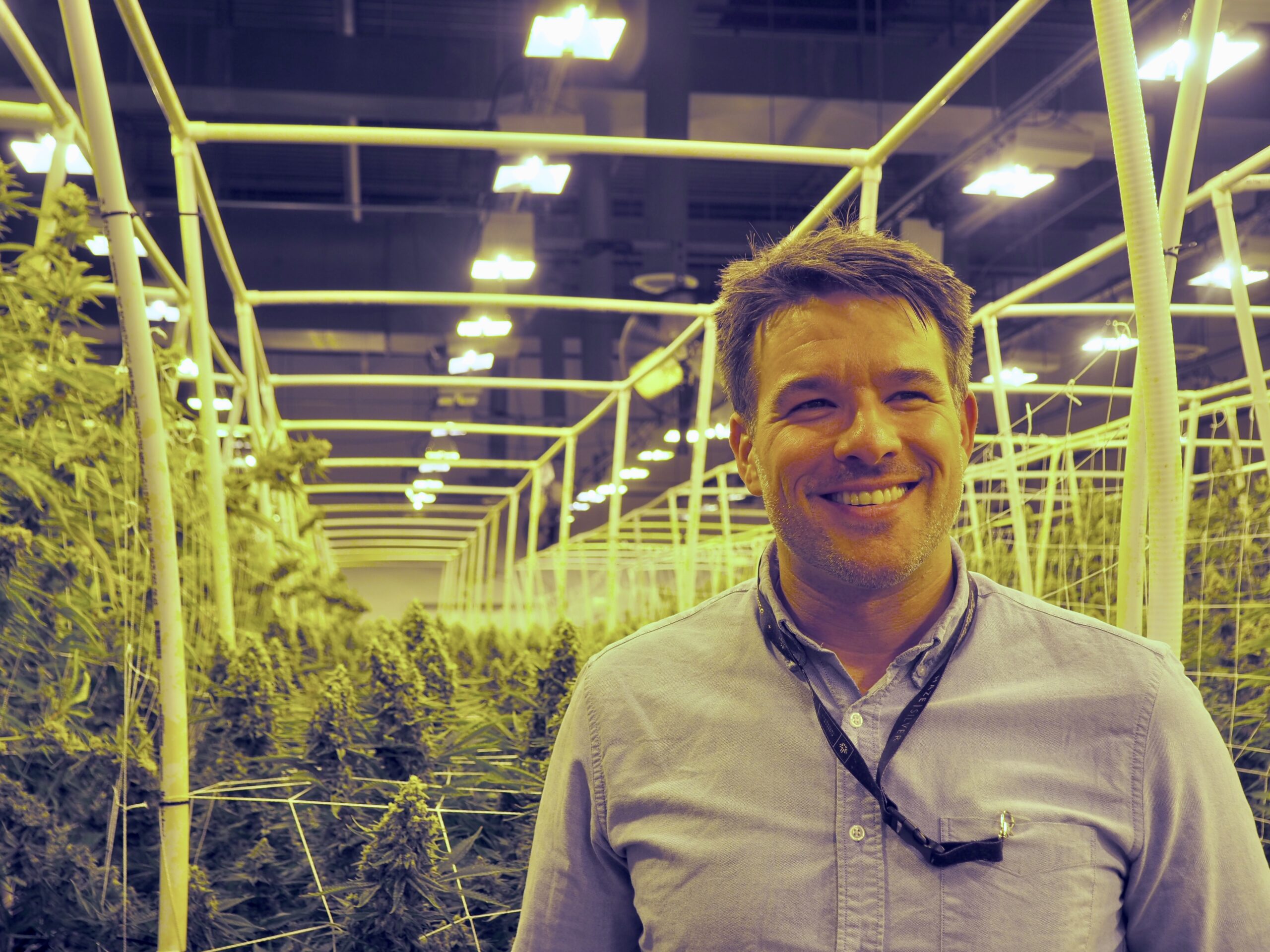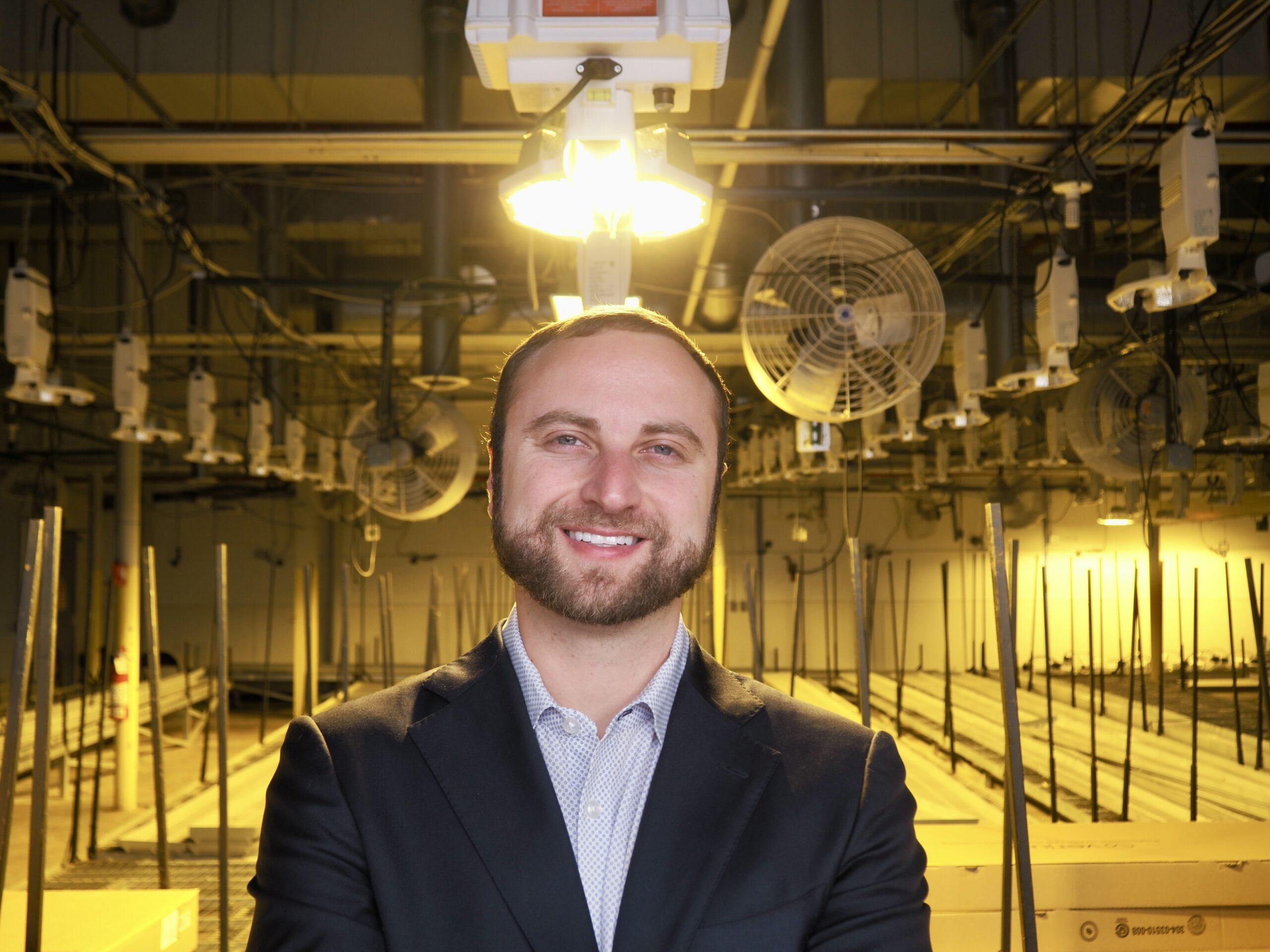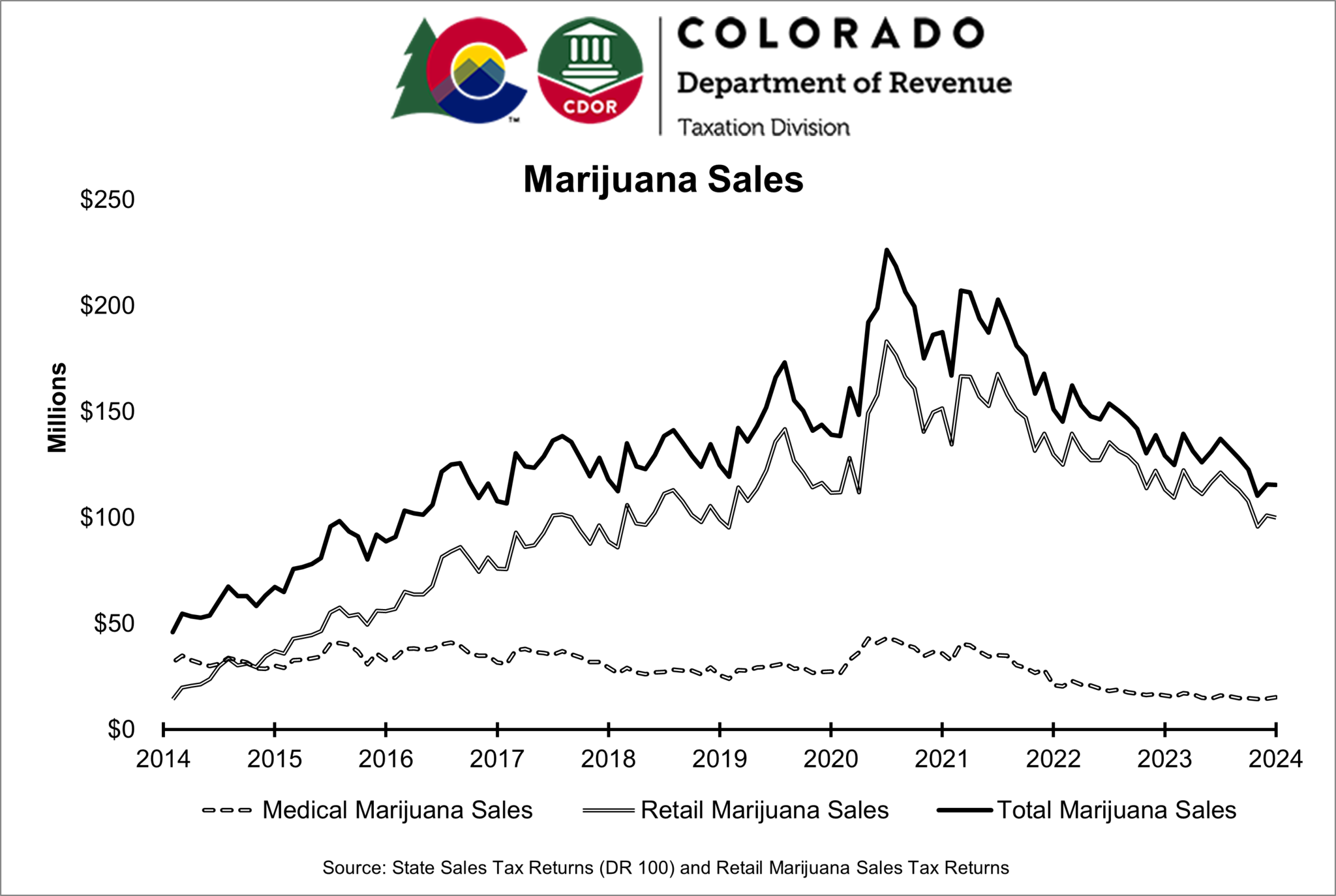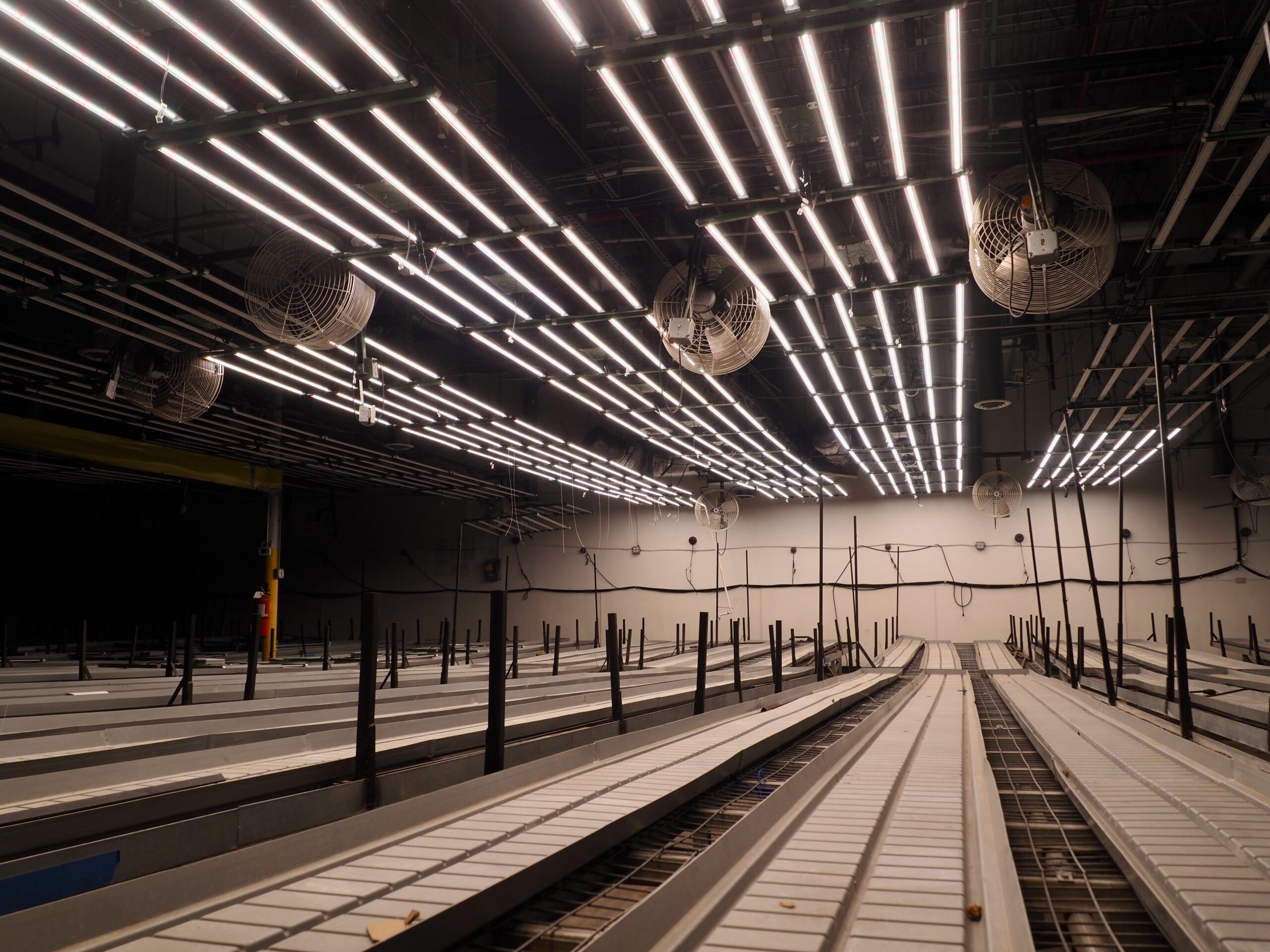
Matt Shifrin, 36, stands inside one of his cultivation rooms. Before entering the weed business, he was the chief operating officer of Breckenridge Distillery. (Matt Geiger/BusinessDen)
In late 2022, real estate broker Jake Malman listed a former marijuana grow facility at 890 Navajo St. in Denver for $9 million.
It would sell for $4.1 million a year later.
“The market dictates pricing ultimately, and they beat it down,” said Malman, the owner of Malman Commercial Real Estate.
While Denver’s industrial real estate market has fared well over the past few years, weed cultivation warehouses have struggled. The pot industry’s business model has evolved since legalization, necessitating a larger and larger square footage footprint for growers, and prompting smaller warehouse operations to close.
Much of their former real estate has failed to sell or lease to new users, leaving millions of industrial square footage vacant.
“When the going was good, they were really happy. But when the market turned and the buildings started to become vacant, you could feel the stress that they were under,” Malman said of building owners.
Historically, marijuana grows have been located in smaller, older and less-functional industrial spaces. They have low ceilings and lack loading bays, opposite of what Malman said are “two of the main driving factors in the industrial sector.”
“Those buildings work great for cannabis, but when they go to resell or re-lease these buildings, they have challenges,” he said.

Jake Malman stands inside a vacant marijuana grow in Denver’s Montbello neighborhood. The broker leased the space to a weed cultivator who will move in soon. (Matt Geiger/BusinessDen)
Some marijuana growers have shifted operations into bigger warehouses. One of those spaces is 11100 E. 51st Ave. in Montbello. Built in 1979 and renovated in 2019, the nearly 60,000-square-foot warehouse has 18-foot-high ceilings and over a dozen loading bays. It’s listed for $11.5 million.
The building is fully occupied by one tenant, Matt Shifrin and his marijuana business Pioneer Interests. It’s one of two grows Shifrin has in the city, the other being a 22,000-square-foot facility a block away. He also owns a combined nine retail dispensaries in Colorado and Illinois under a different brand, Lova.
“I knew I wanted this grow, but it actually wasn’t available when I was first out there … I knew this was going to be my aircraft carrier. I wanted this one,” said Shifrin, who founded Pioneer in 2018.
He ultimately leased the space, a former marijuana grow, in 2019.
“The moment that it became available, we jumped right on it. We showed up on a Wednesday, offer on Thursday, sign the contract on Friday,” Shifrin said, adding that he chose the warehouse due to its large size.
The weed entrepreneur estimates that about 2 million square feet of marijuana cultivation space in Colorado has gone vacant in the past two years. There’s no database which tracks that statistic, he said, so his estimate comes from calculating how much space each plant needs compared with the change in active licenses and number of plants growing.
“Right now I have a list of over a hundred dispensaries that are for sale,” Shifrin said.
In 2023, Colorado’s marijuana sales sank to $1.5 billion, down about 32 percent from a high watermark of $2.2 billion just two years ago. It was the lowest annual total since 2017.

A Colorado Department of Revenue graph showing monthly sales of marijuana in the state. (Colorado Department of Revenue)
The median price for a pound of pot currently sits at $750. It was $1,721 per pound at the start of 2021. The all-time high was over $2,000 for a pound of reefer in 2015.
“How are these businesses making money? Very few are,” Shifrin said.
There have been three “generations” of weed cultivation in Colorado, according to Shifrin. When the plant was first legalized for recreational use in 2012, many grows were mom-and-pop operations in sub-10,000-square-foot warehouses.
“Santa Fe area, small warehouses converted over to that (grows),” he said. “People that were splitting a 20,000-square-foot-long facility into two or three different grows. That was sort of your ‘gen one’ as we would call it.”
“In ’17, ’18, those guys get wiped out.”
The cause for consolidation was partly due to the plummeting price of the plant as more and more growers entered the market. This effectively eliminated the profit margins for smaller cultivators, since they could no longer produce their product for less money than what it was selling for at market rate.
The next generation was housed in bigger facilities, generally 10,000 to 30,000 square feet, Shifrin said. Growers enjoyed a favorable market during the pandemic, when marijuana consumers had few alternatives to “playing video games, drinking booze and smoking weed.”
Then, May 2021 came around. The state began to lift many of its COVID-era restrictions.
“It happened overnight. We saw double-digit declines and traffic almost immediately,” Shifrin said.
This reopening marked a symbolic beginning of the third generation of marijuana growers. With the demand for pot plummeting, the most secure grows were those in large facilities who had the scale to keep their prices low.
“Now, you’re starting to experience the same thing that we did in ’17 and ’18, except that instead of it being the small 4,500-square-foot to 7,500-square-foot grows that went out of business, you’re now getting these eight to 15,000-square-foot grows that are going out of business, up to 30 to 40,000 feet,” Shifrin said.
He added that it’s not just market conditions that are hurting pot purveyors, either.
Marijuana cultivators rent space at $18.50 to $24 per square foot on average, per Shifrin. This is compounded by the fact that these growers “can’t write off s***” because the plant remains federally illegal.
Weed businesses often struggle to secure commercial lending due to their ambiguous legal status. They’re taxed on gross profit, not net income, and cannot deduct normal business expenses, such as interest costs or depreciation, Shifrin said.
All of this, and the business still needs to find a way to grow their product in a profitable manner.

An industrial space that has been used for growing marijuana. (Matt Geiger/BusinessDen)
Cannabis cultivation facilities usually consist of tiny, partitioned rooms which protect from mold, bugs and pesticides spreading around the grow. Each room is outfitted with its own utilities and humidity/temperatures are closely monitored and regulated.
“You’re talking about building a farm, an operating farm, within an industrial warehouse,” Shifrin said.
This is an expensive setup, often costing hundreds of thousands of dollars to construct, and is sometimes even more costly to remove upon a new tenant taking over the space.
It’s precisely the division of the building that makes it expensive and difficult to transact, said Russell Gruber, broker with Gruber Commercial Real Estate.
“Most warehouses want fairly open space,” he said. “They’re running forklifts, material, product … a warehouse with a bunch of demised rooms is a major negative.”
The result is that building owners are having to offer major concessions to get their properties sold. Some throw a bone to buyers with seller financing, others are forking over six figures to have the interiors of the warehouses demolished to make space for other uses.
And if owners don’t do that, they often end up like the space at 1277 S. Bannock St., a small, roughly 5,000-square-foot former marijuana grow that Gruber listed two years ago.
It has remained on the market ever since.
“Potential buyers walk in and are immediately overwhelmed by the work that’s needed,” he said.
Gruber said it and other buildings will eventually sell, though, as “they represent an important piece still of our industrial market.”
“Nobody is off building a 20,000-square-foot central Denver building.”
But for now, they’re vacant. And Gruber said that there’s no use in waiting for other marijuana grows to step in.
“I don’t think that market comes back,” he said.
Back at 890 Navajo St., the new owners — John Victor and partners Matt Jones and Andrew Stettner — recently filed some preliminary plans with the city proposing the building become a car repair facility with an attached showroom.
Victor declined to comment on the submission, saying it was too early in the process.
“I would say we are taking what was an inward-facing, objectively ugly duckling today, and we want to turn that around, draw the neighborhood into it, bring some life, bring some creativity,” he previously told BusinessDen.

Matt Shifrin, 36, stands inside one of his cultivation rooms. Before entering the weed business, he was the chief operating officer of Breckenridge Distillery. (Matt Geiger/BusinessDen)
In late 2022, real estate broker Jake Malman listed a former marijuana grow facility at 890 Navajo St. in Denver for $9 million.
It would sell for $4.1 million a year later.
“The market dictates pricing ultimately, and they beat it down,” said Malman, the owner of Malman Commercial Real Estate.
While Denver’s industrial real estate market has fared well over the past few years, weed cultivation warehouses have struggled. The pot industry’s business model has evolved since legalization, necessitating a larger and larger square footage footprint for growers, and prompting smaller warehouse operations to close.
Much of their former real estate has failed to sell or lease to new users, leaving millions of industrial square footage vacant.
“When the going was good, they were really happy. But when the market turned and the buildings started to become vacant, you could feel the stress that they were under,” Malman said of building owners.
Historically, marijuana grows have been located in smaller, older and less-functional industrial spaces. They have low ceilings and lack loading bays, opposite of what Malman said are “two of the main driving factors in the industrial sector.”
“Those buildings work great for cannabis, but when they go to resell or re-lease these buildings, they have challenges,” he said.

Jake Malman stands inside a vacant marijuana grow in Denver’s Montbello neighborhood. The broker leased the space to a weed cultivator who will move in soon. (Matt Geiger/BusinessDen)
Some marijuana growers have shifted operations into bigger warehouses. One of those spaces is 11100 E. 51st Ave. in Montbello. Built in 1979 and renovated in 2019, the nearly 60,000-square-foot warehouse has 18-foot-high ceilings and over a dozen loading bays. It’s listed for $11.5 million.
The building is fully occupied by one tenant, Matt Shifrin and his marijuana business Pioneer Interests. It’s one of two grows Shifrin has in the city, the other being a 22,000-square-foot facility a block away. He also owns a combined nine retail dispensaries in Colorado and Illinois under a different brand, Lova.
“I knew I wanted this grow, but it actually wasn’t available when I was first out there … I knew this was going to be my aircraft carrier. I wanted this one,” said Shifrin, who founded Pioneer in 2018.
He ultimately leased the space, a former marijuana grow, in 2019.
“The moment that it became available, we jumped right on it. We showed up on a Wednesday, offer on Thursday, sign the contract on Friday,” Shifrin said, adding that he chose the warehouse due to its large size.
The weed entrepreneur estimates that about 2 million square feet of marijuana cultivation space in Colorado has gone vacant in the past two years. There’s no database which tracks that statistic, he said, so his estimate comes from calculating how much space each plant needs compared with the change in active licenses and number of plants growing.
“Right now I have a list of over a hundred dispensaries that are for sale,” Shifrin said.
In 2023, Colorado’s marijuana sales sank to $1.5 billion, down about 32 percent from a high watermark of $2.2 billion just two years ago. It was the lowest annual total since 2017.

A Colorado Department of Revenue graph showing monthly sales of marijuana in the state. (Colorado Department of Revenue)
The median price for a pound of pot currently sits at $750. It was $1,721 per pound at the start of 2021. The all-time high was over $2,000 for a pound of reefer in 2015.
“How are these businesses making money? Very few are,” Shifrin said.
There have been three “generations” of weed cultivation in Colorado, according to Shifrin. When the plant was first legalized for recreational use in 2012, many grows were mom-and-pop operations in sub-10,000-square-foot warehouses.
“Santa Fe area, small warehouses converted over to that (grows),” he said. “People that were splitting a 20,000-square-foot-long facility into two or three different grows. That was sort of your ‘gen one’ as we would call it.”
“In ’17, ’18, those guys get wiped out.”
The cause for consolidation was partly due to the plummeting price of the plant as more and more growers entered the market. This effectively eliminated the profit margins for smaller cultivators, since they could no longer produce their product for less money than what it was selling for at market rate.
The next generation was housed in bigger facilities, generally 10,000 to 30,000 square feet, Shifrin said. Growers enjoyed a favorable market during the pandemic, when marijuana consumers had few alternatives to “playing video games, drinking booze and smoking weed.”
Then, May 2021 came around. The state began to lift many of its COVID-era restrictions.
“It happened overnight. We saw double-digit declines and traffic almost immediately,” Shifrin said.
This reopening marked a symbolic beginning of the third generation of marijuana growers. With the demand for pot plummeting, the most secure grows were those in large facilities who had the scale to keep their prices low.
“Now, you’re starting to experience the same thing that we did in ’17 and ’18, except that instead of it being the small 4,500-square-foot to 7,500-square-foot grows that went out of business, you’re now getting these eight to 15,000-square-foot grows that are going out of business, up to 30 to 40,000 feet,” Shifrin said.
He added that it’s not just market conditions that are hurting pot purveyors, either.
Marijuana cultivators rent space at $18.50 to $24 per square foot on average, per Shifrin. This is compounded by the fact that these growers “can’t write off s***” because the plant remains federally illegal.
Weed businesses often struggle to secure commercial lending due to their ambiguous legal status. They’re taxed on gross profit, not net income, and cannot deduct normal business expenses, such as interest costs or depreciation, Shifrin said.
All of this, and the business still needs to find a way to grow their product in a profitable manner.

An industrial space that has been used for growing marijuana. (Matt Geiger/BusinessDen)
Cannabis cultivation facilities usually consist of tiny, partitioned rooms which protect from mold, bugs and pesticides spreading around the grow. Each room is outfitted with its own utilities and humidity/temperatures are closely monitored and regulated.
“You’re talking about building a farm, an operating farm, within an industrial warehouse,” Shifrin said.
This is an expensive setup, often costing hundreds of thousands of dollars to construct, and is sometimes even more costly to remove upon a new tenant taking over the space.
It’s precisely the division of the building that makes it expensive and difficult to transact, said Russell Gruber, broker with Gruber Commercial Real Estate.
“Most warehouses want fairly open space,” he said. “They’re running forklifts, material, product … a warehouse with a bunch of demised rooms is a major negative.”
The result is that building owners are having to offer major concessions to get their properties sold. Some throw a bone to buyers with seller financing, others are forking over six figures to have the interiors of the warehouses demolished to make space for other uses.
And if owners don’t do that, they often end up like the space at 1277 S. Bannock St., a small, roughly 5,000-square-foot former marijuana grow that Gruber listed two years ago.
It has remained on the market ever since.
“Potential buyers walk in and are immediately overwhelmed by the work that’s needed,” he said.
Gruber said it and other buildings will eventually sell, though, as “they represent an important piece still of our industrial market.”
“Nobody is off building a 20,000-square-foot central Denver building.”
But for now, they’re vacant. And Gruber said that there’s no use in waiting for other marijuana grows to step in.
“I don’t think that market comes back,” he said.
Back at 890 Navajo St., the new owners — John Victor and partners Matt Jones and Andrew Stettner — recently filed some preliminary plans with the city proposing the building become a car repair facility with an attached showroom.
Victor declined to comment on the submission, saying it was too early in the process.
“I would say we are taking what was an inward-facing, objectively ugly duckling today, and we want to turn that around, draw the neighborhood into it, bring some life, bring some creativity,” he previously told BusinessDen.
